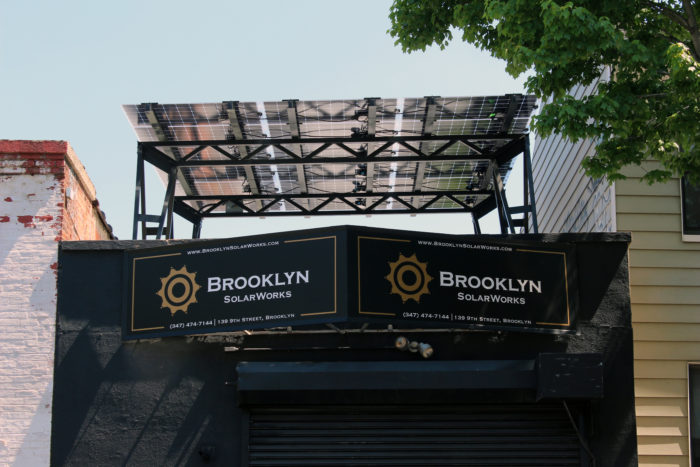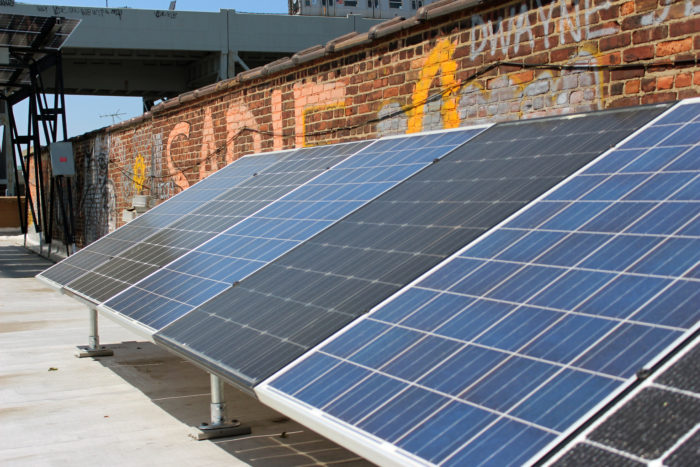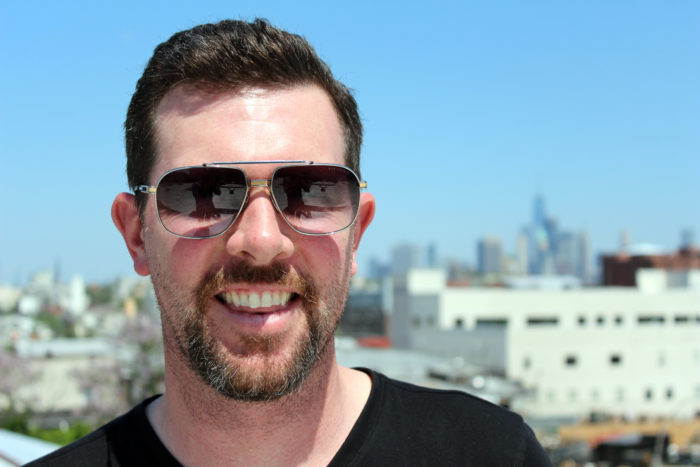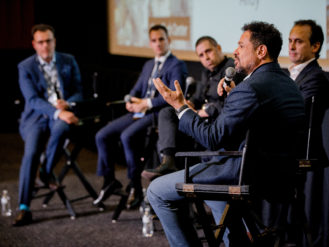Putting the Sun to Work on Brooklyn Rooftops
How a local solar-power startup's innovative design fits in tight spots and meets the city's rigorous codes
A canopy of their own design is installed on the Brooklyn SolarWorks rooftop (Photos by Patrick Smith)
It’s about 90 degrees at 11 a.m. Unseasonably warm for Brooklyn in May, and T.R. Ludwig is standing on a rooftop with a reflective gray surface bouncing those powerful sun rays right back up at him. But Ludwig is not uncomfortable with this. The bright blast pounding him is the source of his power. Literally.
Ludwig is the co-founder and CEO of Brooklyn SolarWorks, a residential solar-power company that has pioneered a way to harvest the sun’s energy in the dense neighborhoods of Brooklyn using a canopy system. Ludwig hopes these aesthetically friendly and functional systems can make solar power, already popular in suburbs and exurbs, a common feature in the heart of the city.
After starting the business in an abandoned oil depot in Williamsburg, the company moved to a startup-style office in Gowanus (complete with requisite dogs and beer). The company has grown because it solves a problem: how do you get enough solar panels on a flat-roofed structure to create usable power? Their residential canopy crosses that threshold, does it within New York City building and fire codes.
Mom Was a Hippy
Ludwig was interested in environmental issues from a young age. He attributes this to his mother, who he says has been an environmental activist for 50 years. A native of Lexington, MA, Ludwig majored in environmental studies and geology at Ohio Wesleyan University, then got his MBA in the Netherlands. When he landed in New York a decade ago, he worked for more established energy companies like Ad Energy and Sunrun before setting out, with two partners, to create Brooklyn SolarWorks. Their mission: to deal with the intricacies of installing solar power in buildings that required a lot more individual attention than larger companies, who work at scale, were prepared to deal with.

A tilt-rack solar panel designed and installed by Brooklyn SolarWorks
“The customers that we have to deal with, you have to be prepared to over-inform people what is happening on their house, and I think that makes a difference. We get perceived differently than a normal contractor,” Ludwig said.
Innovation from the Margins
Chris Neidl, who has been involved in the solar-power industry for over 15 years, met Ludwig when he came to Neidl’s lectures on solar-power usage. Then they worked together on an initiative called “Here Comes Solar,” a nonprofit program designed to bring residential solar to New York City.
The larger national companies, who Neidl said were doing well enough with straightforward installations on large commercial buildings and suburban residences, were unwilling to dive into the series of issues that were involved with getting solar to more urban areas. And that is where Brooklyn SolarWorks came in. “Innovation always occurs in the margins,” Neidl said. “Incumbents don’t do this. It has to come from the edge. [The larger companies] wouldn’t touch it with a 10-foot pole,” he said. Turns out it would need to be several poles, many of which were longer than ten feet.
The Canopy Structure
There were several issues that make it difficult to install productive solar panels on a flat-roofed residential building. One issue is figuring out a way to share the energy among multiple tenants in a single dwelling and how that energy would be billed (or credited) by utilities. But the major issue was dealing with the codes–building, electrical, mechanical and fire–that make it illegal to simply lay tiles on a roof.

T.R. Ludwig, CEO of Brooklyn SolarWorks
Section 512.2 of the New York City fire code states that “solar panel installations shall not obstruct any rooftop area access…” That’s a challenge. Ludwig and his team partnered with Brooklyn-based SITU Design Studios to come up with a secure structure that could create the elevation and space necessary to adhere to the codes while still being easy on the eyes. “We took our time with it,” Ludwig said. “It’s probably over-engineered,” he said with a wry smile. (The structures are designed and engineered in Brooklyn, then fabricated in Rhode Island.)
Ludwig said the canopy is most often brought to the roof of buildings using pulleys and then assembled, although they have also used cranes. Once the paperwork is done, a typical installation can be done in two to three days. Although Ludwig’s team is well-practiced at the paperwork, it can still take up to three months to complete and is the largest delay in getting the system operational.
Doing the Math
The structures typically cost between $35,000 to $40,000, although some larger projects have run over $70,000. While that’s daunting, Ludwig says that various state, federal and city incentive programs can cover 70% to 90% of the overall cost. He said a typical family of four uses about 8,000 kilowatt hours (kWh) annually. A typical canopy generates slightly less than that, the canopies are modular and can scale up if a family wants to try offsetting all their electrical costs.
“You’re essentially pre-paying for your electricity,” Ludwig said. For example, you purchase a $40,000 canopy and receive the 70% incentive, meaning the structure will cost you about $12,000. At $.20/kWh (as of 2016) for electricity in the Tri-State Area and using the 8,000 kWh annual usage figure, a typical house is looking at around $1,600 annually for electricity. Once all the math is done, according to the numbers provided by Brooklyn SolarWorks, it appears you can pay for a lifetime of electricity in the home in a little over seven years.
At this point, Brooklyn SolarWorks is doing about two to three installations a week, which is where Ludwig says they want to be. Rather than scale up their own installations as the company grows, Ludwig would rather create a distribution model that allows other companies to utilize the Brooklyn design. Expanding the use of their design and creating a local industry around it are where Ludwig sees the company going: “Creating, designing, and hopefully soon to be fabricating this structure specifically for this area in Brooklyn, which will create quite a few jobs.”













